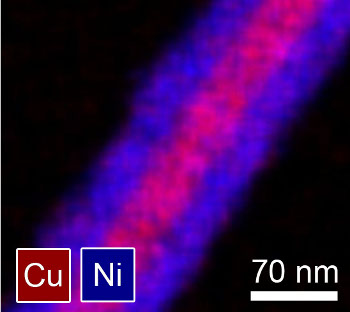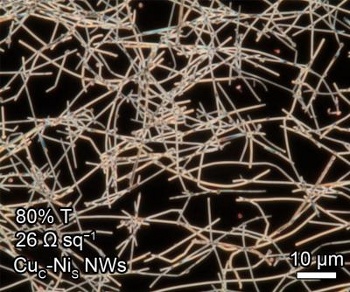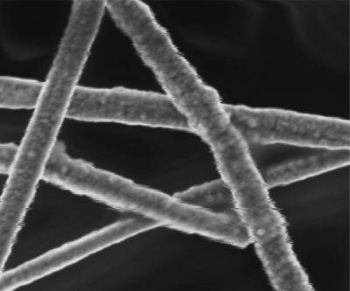Copper Nanowires for Solar Cells
December 6, 2013
You need
electrical conductors to make
electrical devices. You can use
copper wire for larger devices, like
table lamps and
motors, but
integrated circuits need to have small conductive traces of
metal applied directly to the
semiconductor chip. Although
aluminum, and now
copper, are used as conductors on
integrated circuits, they aren't the only high
conductivity (low
resistivity) metals, as the following table shows.
† 18% Cr, 8% Ni
Austenitic
As you can see from the table,
alloys of metals have a higher resistivity than
pure metals, a fact that's easily explained by a
classical model of electrical conductance called the
Drude model.
So, we have quite a panoply of
materials to use in our electrical devices; but, a problem arises when you need an electrical conductor that's also
transparent for use in
displays and
solar cells. Although
metals are good electrical conductors because of their mobile
electrons, the same electrons responsible for the conductivity also scatter
photons, so metals are
reflective, not transparent. Some "simple metals," copper, silver, and gold, are both transparent and conductive, but only when they are
thin films, and not that conductive.
I reviewed a number of transparent conductor alternatives in three previous articles:
Transparent and Conductive (June 10, 2011),
Silver Nanowire Transparent Electrodes (December 19, 2011), and
Nickel-Copper Nanowires (June 5, 2012).
If you want a reasonably conductive material that's transparent at
visible wavelengths, then
indium-tin oxide (ITO) is the most developed candidate. ITO's resistivity, about 10
−4 ohm-
cm, is adequate for both display and solar cell applications, but the primary problem with ITO is the price of
indium, as high as $650/
kilogram in 2012.[1] Not surprisingly, many
scientists are looking for alternatives to ITO.
One approach is to use a low
concentration dispersion of
carbon nanotubes in a transparent material. While it's desirable to have a low nanotube concentration for greatest transparency, the concentration must be higher than the
threshold for electrical percolation. Even then, the conductivity is not that large.
A network of silver
nanowires has been used instead of a carbon nanotube dispersion. The nanowires, overcoated with the
conductive polymer,
PEDOT:PSS (poly(3,4-ethylenedioxythiophene) poly(styrenesulfonate)), to increase wire-wire connection, form a high quality transparent electrode.[2-3]
As I wrote in a
previous article (Nickel-Copper Nanowires, June 5, 2012),
Benjamin Wiley, an
assistant professor of
chemistry at
Duke University, and his students have been doing research on copper nanowire transparent electrodes. Copper is as conductive as silver, but much more abundant and a lot less expensive (less than $4.00/
lb. vs more than $400/lb.).
The problem with copper is that it will
oxidize when exposed to
air. Last year, the Duke research team solved this problem by a process in which the copper nanowires are coated with a thin layer of nickel (see figure).[4-5] The nickel layer was found to be an effective means of maintaining the copper conductivity for hundreds of years.[4]

Image of a nickel-coated copper nanowire.
(Image supplied by Benjamin Wiley, used with permission)
Research on these nickel-coated copper nanowires has continued with application as
catalytic electrodes for
water photolysis, and the results have been published in a recent issue of
Angewandte Chemie.[6-7] Nickel and cobalt-coated copper nanowire network electrodes were fabricated with seven times better transparency than the 80% transparency of ITO. The electrodes, which function at the
oxidation half-reaction of the water-splitting
reaction, are also
flexible.[7]

Dark-field optical microscopy of a network of copper nanowires.
(Duke University image by Zuofeng Chen.)
The Duke research was funded by the
National Science Foundation.[7] Wiley has started
NanoForge Corp., a
Durham, North Carolina, startup company, to develop such materials.[4]

Scanning electron micrograph of nickel-coated copper nanowires intended for water photolysis.
(Duke University image by Zuofeng Chen.)
![]()
References:
- US Geological Survey, Indium - USGS Mineral Resources Program, Mineral Commodity Summaries, 2013 (201 page PDF file).
- Jennifer Marcus, "UCLA team develops highly efficient method for creating flexible, transparent electrodes," UCLA Press Release, November 21, 2011.
- Rui Zhu, Choong-Heui Chung, Kitty C. Cha, Wenbing Yang, Yue Bing Zheng, Huanping Zhou, Tze-Bin Song, Chun-Chao Chen, Paul S. Weiss, Gang Li and Yang Yang, "Fused Silver Nanowires with Metal Oxide Nanoparticles and Organic Polymers for Highly Transparent Conductors," ACS Nano, vol. 5. no. 12 (October 28, 2011), pp. 9877-9882.
- Ashley Yeager, "Copper-Nickel Nanowires Could Be Perfect Fit For Printable Electronics," Duke University Press Release, May 29, 2012.
- Aaron R Rathmell, Minh Nguyen, Miaofang Chi and Benjamin John Wiley, "Synthesis of Oxidation-Resistant Cupronickel Nanowires for Transparent Conducting Nanowire Networks," Nano Letters, vol. 12, no. 6 (May 29, 2012), pp. 3193-3199.
- Zuofeng Chen, Aaron R. Rathmell, Shengrong Ye, Adria R. Wilson and Benjamin J. Wiley, "Optically Transparent Water Oxidation Catalysts Based on Copper Nanowires," Angew. Chem. Int. Ed., Online before Print (October 18, 2013), DOI: 10.1002/anie.201306585.
- Copper Promises Cheaper, Sturdier Fuel Cells, Duke University Press Release, November 22, 2013.
Permanent Link to this article
Linked Keywords: Electrical conductor; electronics; electrical device; copper; wire; light fixture; table lamp; electric motor; integrated circuit; metal; semiconductor; aluminum; copper interconnect; copper; conductivity; resistivity; silver; iron; copper; platinum; gold; tin; aluminium; aluminum; 1010 carbon steel; calcium; lead; tungsten; titanium; zinc; stainless steel; nickel; mercury; lithium; nichrome; austenitic stainless steel; alloy; chemical element; pure metal; kKinetic theory; classical model; Drude model; material; transparency; transparent; display; solar cell; metal; electron; photon; reflection; thin film; visible spectrum; visible wavelength; indium-tin oxide; ITO; ohm; centimeter; cm; indium; kilogram; scientist; concentration; dispersion; carbon nanotube; threshold for electrical percolation; nanowire; conductive polymer; PEDOT:PSS; Benjamin Wiley; assistant professor; chemistry; Duke University; pound mass; lb.; oxide; oxidize; atmosphere of Earth; air; catalysis; catalytic; electrode; water; photodissociation; photolysis; Angewandte Chemie; oxidation half-reaction; chemical reaction; stiffness; flexible; Dark-field optical microscopy; Zuofeng Chen; National Science Foundation; NanoForge Corp.; Durham, North Carolina; scanning electron microscope; electron micrograph; US Geological Survey, Indium - USGS Mineral Resources Program, Mineral Commodity Summaries, 2013.